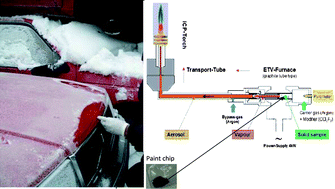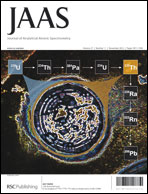Pieces of automotive paint often constitute trace evidence at crime scenes, especially in hit-and-run cases. As minute amounts of sample generally are available for forensic analysis, sensitive direct analysis methods are preferable to multi-step methods that may lead to sample contamination and/or analyte loss. Such a simple method was developed for discrimination of automotive paint samples. It involves solid sampling electrothermal vaporization (ETV) coupled to inductively coupled plasma optical emission spectrometry (ICP-OES) and multivariate analysis. A total of 18 automotive paint fragments were collected by scraping six red-colored car wrecks from three sides (front, side and back). Two replicates of each paint fragment were analysed. In each case, 0.8–2.0 mg paint was directly weighed onto an ETV graphite boat, which was then inserted into the ETV furnace for vaporization at 2200 °C. The vaporization products were carried into the ICP by Ar carrier gas containing dichlorodifluoromethane reactant gas. For classification of paint samples according to their sources, several elements were simultaneously monitored. No sample pretreatment or quantification of the elements was needed. Point-by-point normalization of the emission signal of each analyte to an Ar emission line was carried out, followed by integration of the resulting transient signal. The data matrices composed of the integrated areas (divided by sample mass) for the different elements were then subjected to principal component analysis (PCA), cluster analysis and linear discriminant analysis (LDA). After identifying the major contributing variables by PCA, LDA was performed and showed that a combination of three/four variables from Cr, Pb, Sn, and Zn correctly assigned each of 18 red paint samples to the correct source car. Hence, solid sampling ETV-ICP-OES, which only requires a very small amount of sample, is a simple technique for forensic automotive paint analysis, i.e. for the identification of the make and model of a car in question.


 Please wait while we load your content...
Please wait while we load your content...